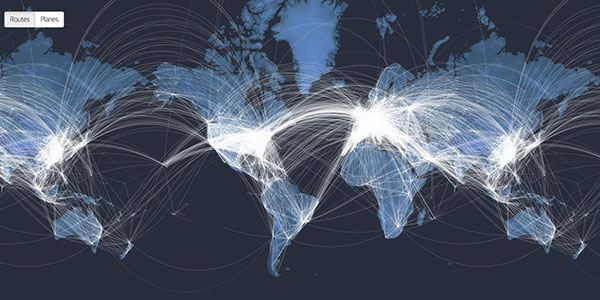
Despite widespread agreement that real-time aircraft tracking must be at the top of the air transport industry’s list of priorities, the adoption of tracking solutions continues to be slower than everyone would like. ICAO’s mandate that airlines must adopt 15-minute position reporting as standard will not be implemented until November 2018, while from January 2021 aircraft will need to satisfy the Standards and Recommended Practices (SARPS) on “distress” tracking, which means aircraft location must be reported at least every minute when an aircraft is in distress.
Offering its thoughts on the 2018 deadline, IATA, which has liaised closely with ICAO on the development of the aircraft tracking standards, told FTE in a statement: “The November 2018 tracking requirement was arrived at through the ICAO process with involvement from all stakeholders. In order to achieve it, we are working through the Normal Aircraft Tracking Implementation Initiative 2 (NATII 2) to now create guidance material to help airlines and regulators to implement the tracking standard. The recently adopted Standards and Recommended Practices and the newly proposed risk-based SARP to complement the existing Standards, will become effective from March 2017, giving the industry 18 months to assess where they are, in order to comply with the November 2018 deadline.”
Not everyone is happy with these timeframes, though, and as has been widely reported, Emirates President Sir Tim Clark labelled the slow rate of progress a “disgrace” at this month’s IATA AGM. While Clark’s strong words highlight the frustration felt by many both within and outside of the industry, it is important to note that in some areas more urgent action is being taken to address the need for real-time tracking. For instance, the Civil Aviation Authority of Singapore (CAAS) announced three months ago that all Singapore-based airlines must meet the 15-minute aircraft position reporting standard by 1 July 2016.
Dozens of airlines have also taken a proactive approach and SITAONAIR told FTE that around 40 carriers have now adopted its FlightTracker product, which uses existing equipment and re-purposes air traffic control data to provide consistent monitoring throughout the flight. Other suppliers are also active in this space. Panasonic Avionics announced earlier this month that it is now offering global tracking to all Satcom customers, which it says will enable it to “seamlessly enable flight tracking on over 1,500 aircraft, and we expect to extend this capability to over 3,500 aircraft over the short term”. Meanwhile, Rockwell Collins offers flight tracking via its ARINC MultiLink service and the Aireon Aircraft Locating and Emergency Response Tracking (ALERT) service is undergoing tests with the Irish Aviation Authority and is due to go live in 2018.
Whose responsibility is flight tracking?
As Paul Gibson, Portfolio Director, AIRCOM, SITAONAIR, explained to FTE, there are still some questions to be answered before real-time aircraft tracking becomes the norm rather than the exception. “I think there are a couple of issues,” he started. “One is I think there’s some debate in the industry about whether tracking is the responsibility of the air navigation service providers or the airlines. I think that debate hasn’t been fully resolved yet so I think to some extent at least the airlines are saying if it’s a safety issue then that’s what ATC is for. But the ICAO recommendation for 15-minute tracking was aimed at being something that the airlines would be expected to meet. The other thing is – and this is an issue we’re trying to help with – the lack of clarity on the technology and how it can be implemented easily. The OEMs – Boeing and Airbus – are looking at additional hardware on the aircraft in future generation of aircraft that could help with tracking. Our position has been that the tracking technology already on the aircraft is just not very easy for the airlines to use effectively. That’s the problem that we’ve been trying to solve.” Gibson explained that a wide variety of technologies exist to track aircraft, including ADS-B, ADS-C and ACARS, and SITAONAIR has tapped into these to create its own flight tracking service. However, he stated: “Ultimately, the solution will include some new equipment on the aircraft.”
He continued: “One of the issues is, and it’s kind of ironic, that the industry is rightly very focused on safety and has a lot of regulation and processes around it to keep that safety record. The ironic part is this means that something like putting a new tracking device on an aircraft doesn’t happen quickly. There’s a lot of procedure and regulation to go through before that can happen. From an airline perspective it’s very expensive and takes a very long time to install new technology onboard the aircraft. Also, from an airline’s point of view it’s reasonable for them to wait for the industry to have a standard for that equipment on the aircraft before they deploy it widely. Ultimately, that technology would need to include some kind of battery-powered back-up, because the tracking technology that is on the aircraft today is obviously reliant on the main power buses, so if for whatever reason those power buses are interrupted, then you lose the tracking, which is arguably the time when you most need it.”
SITAONAIR, Gibson explained, is now exploring how it can leverage the broadband connectivity on connected aircraft to stream data – such as engine data and aircraft health data – based on a trigger from FlightTracker. “It’s not reasonable to do that on current satellite technology all the time from all aircraft,” he said, “but it’s certainly something you could do when you need to.”
Clearly, industry suppliers are making concerted efforts to help improve and drive uptake of real-time flight tracking, but with the implementation of ICAO’s flight tracking standard not coming into effect until late 2018, it seems there is only so much that can be achieved before then. All things considered, the implementation date cannot come soon enough.







